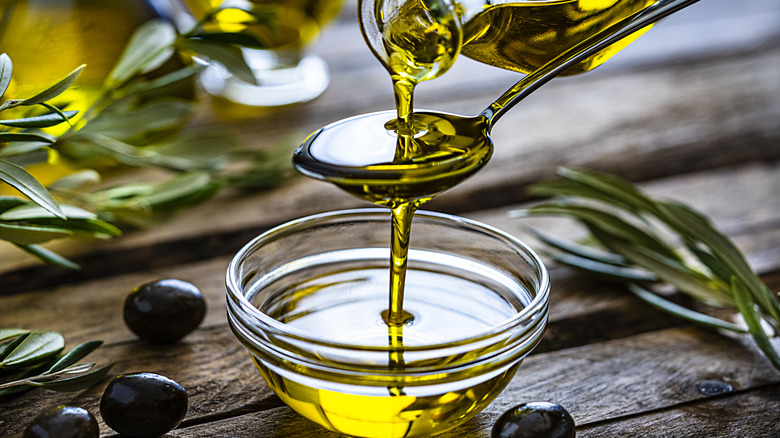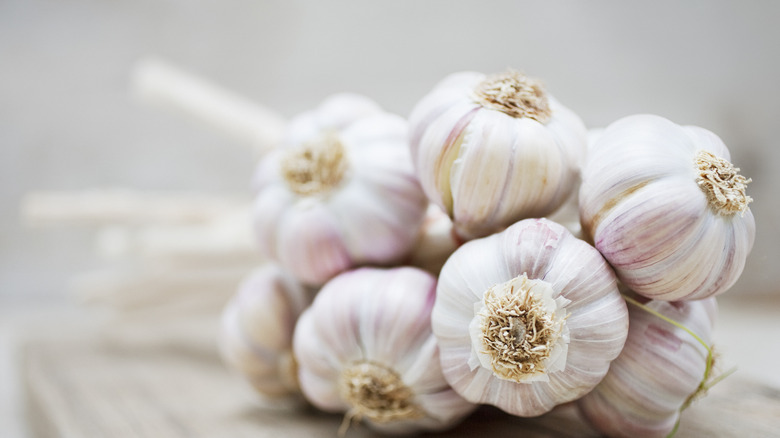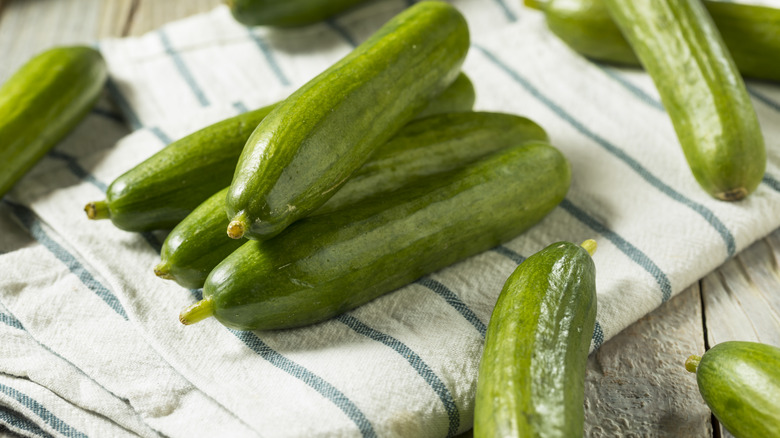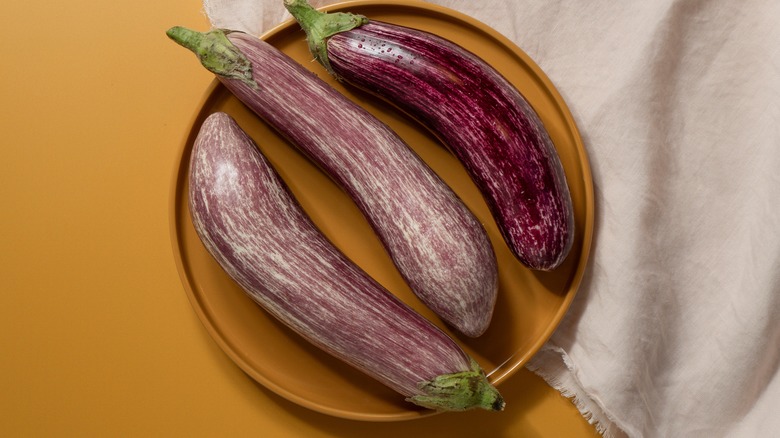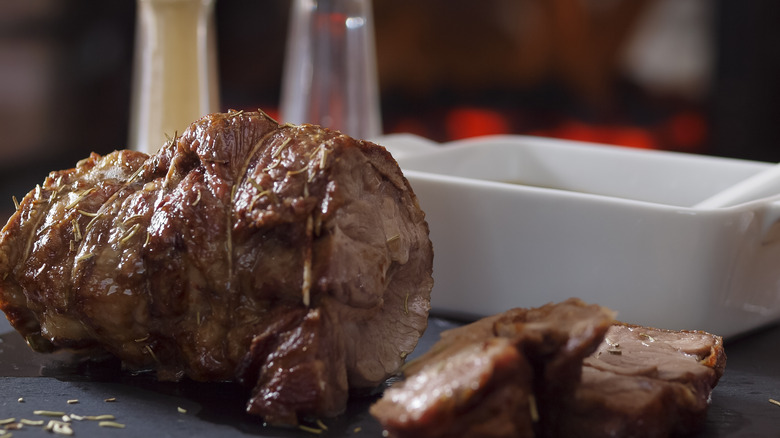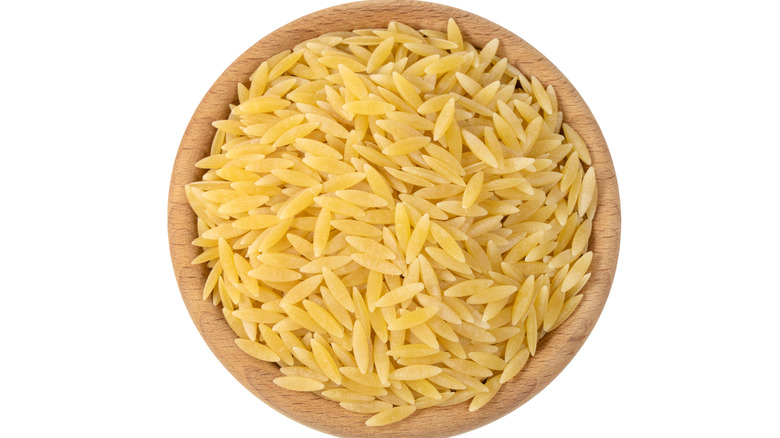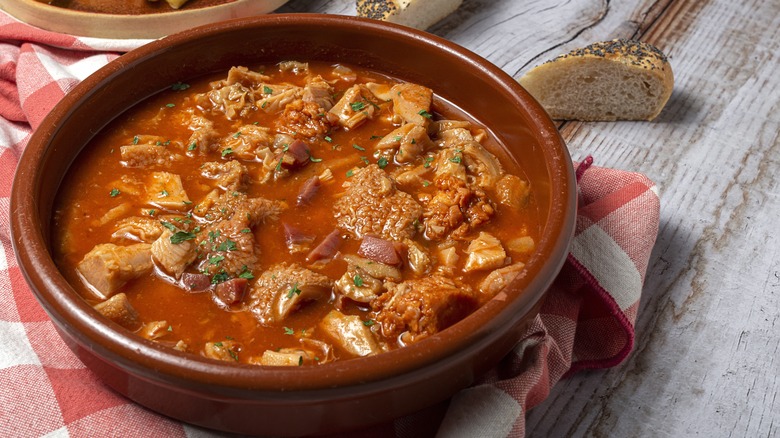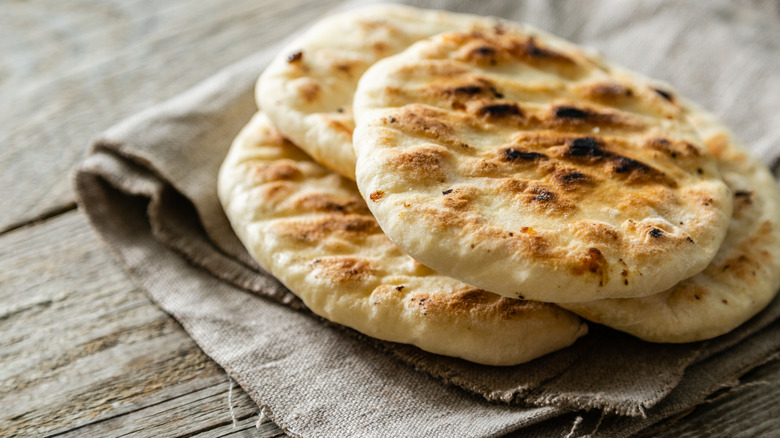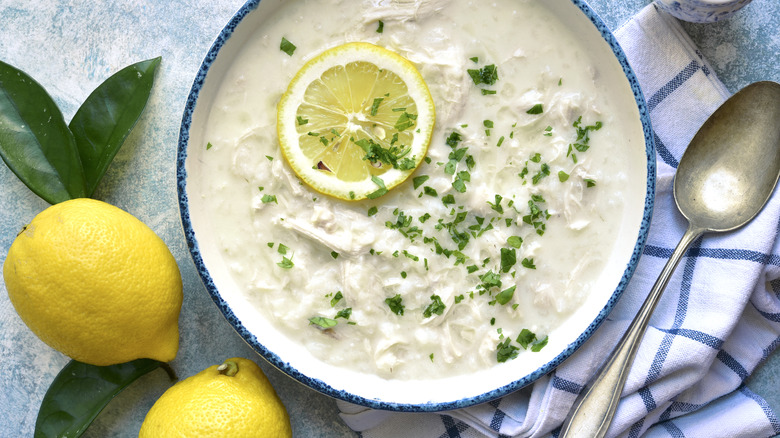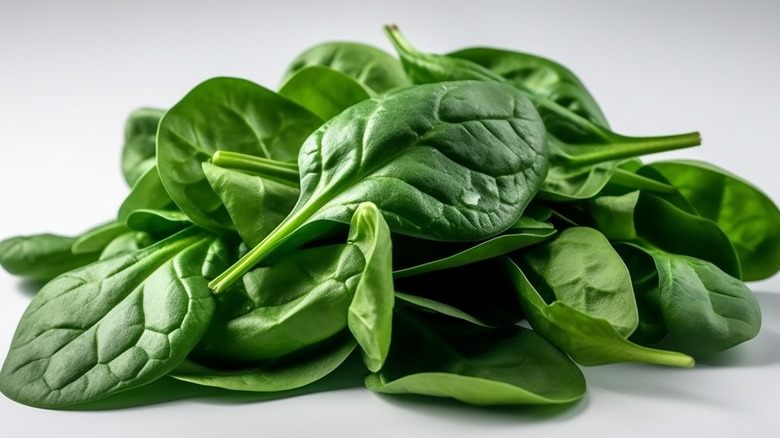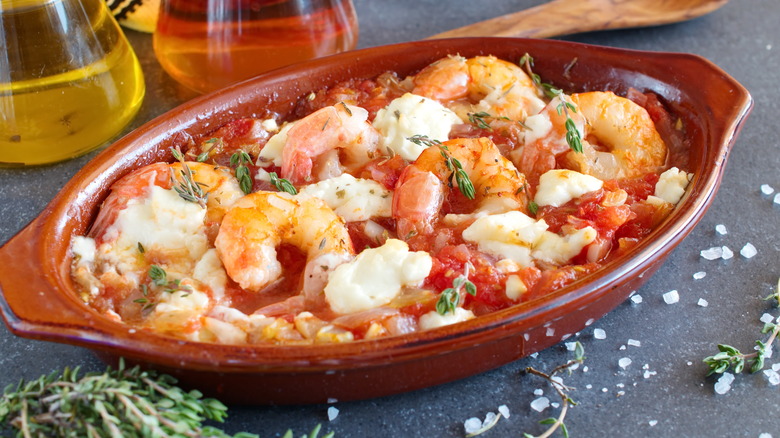30 Essential Greek Ingredients, Explained
From sun-beaten islands to bustling city streets, Greece's culinary tradition is a tapestry woven with rich history and local charm, each of which stretches back millennia. Although neighboring countries to the west — like Italy, France, and Spain — have cultivated elite reputations for pushing gastronomic boundaries, today, the ecosystem of Greek food stakes an individual claim for itself by representing a strong connection to ages past. Rather than carrying on a dusty, tired cuisine, Greeks show that food anchored in humble, time-honored components can be just as exciting as innovative food science experiments.
No matter if you're on the search for a new frontier of global cuisine that you've yet to try or you're hoping to get more familiar with cooking a new delicacy, having a general knowledge of the essential ingredients within Greek cuisine can help you stay aware of what flavors are out there. It can also help you find new flavors to bring into your own home kitchen, as well. Opa!
Olive oil
If a single ingredient can represent the heart of Greek gastronomy, it's olive oil. There are as many varieties of oils as there are villages in the country, but the national cuisine is built around this small fruit. Olive oil is a crucial ingredient in Greek cooking.
Spanakopita boasts a flaky crust infused by its vegetal contrasts, and dishes like seafood saganaki require a sizzle of olive oil to reach the perfect texture. Beyond heating, Greek extra virgin olive oil marries the feta, tomatoes, and cucumbers of a Horiatiki-style salad, dolmas glisten with its touch, and drizzled over baklava, it makes a crowning golden finish.
Feta
Feta is another cornerstone of Greek cuisine and the undisputed poster product for Greek cheese. The firm but crumbly blocks of salty cheese are traditionally fermented from sheep's milk, but nowadays, it might be made from cow, goat, or sheep's milk.
Feta cheese is used to impart a distinct tang to many dishes, especially in places where fatty salinity could be used. When crumbled over traditional Greek salads, it adds a creamy personality to fresh vegetables and serves the same role when piled into a pita with souvlaki, stuffed inside a pepper, or adding a bite to spanakopita.
Olives
As far as ingredient usage is concerned, olives and olive oil serve two different purposes as ingredients in Greek cooking. However, because of their importance, the two are never far from each other.
The purplish-black Kalamata olives, briny and rich, are perhaps the most commonly known type of olive from Greece, but with over 100 varieties, these fruits come in a wide variety of sizes, colors, and flavor profiles. Olives are never served raw but are always preserved before being served as a tapenade on mezze platters, chopped in a salad, or as an appetite-tempering snack before a meal.
Greek yogurt
Just like the belief that tomatoes are Italian, it's a common misconception that Greek yogurt comes from Greece. The first act of straining yogurt is hard to pin down, but it's likely that it came from somewhere in the Fertile Crescent region.
That said, this zesty dairy product plays a massive role in present-day Greek cooking. Tzatziki, a dip/sauce made of cucumbers and herbs, gets its refreshing lift from yogurt. Similarly, Greek yogurt brings a velvety consistency to moussaka and is a standalone treat of yogurt, honey, and nuts.
Oregano
Oregano is a common, fragrant type of herb found across Mediterranean cuisines, especially in Greece. Many countries have unique, native varieties. For instance, Greek oregano is a particular type that features a broader, larger leaf and thicker stem than its Italian relative. It has a deeper, woodsier flavor and aroma.
Dried or newly picked, oregano is used to enhance the freshness of vegetables, feta, roasted or grilled meats, and seafood. In particular, keftedes (Greek meatballs) and pastitsio (beef baked with pasta cheese) are two dishes that benefit from a hefty herbal sprinkling.
Pomegranate
Greek tradition associates pomegranates with luck, abundance, and fertility, which should completely track with anyone who has ever tasted this fruit in its freshest form. The flavor is kinetic — at once sweet, fruity, refreshing, and puckering. The red or pink jewels hang like an end-of-summer gift to be harvested around October and November.
Fresh pomegranate seeds add visual allure on top of Greek salads and enlivened, subtle acidity in the marinade of slow-roasted lamb kleftiko. Sweetness is accentuated in the form of pomegranate molasses, which is also used as a syrupy compliment to dolmas or the finishing touch of karydopita, a Greek walnut cake.
Garlic
Many international cuisines leverage the bold traits of garlic to impart pungency to food — Greek cooking is certainly one of them. The bold and aromatic essential is woven intricately into the fabric of Greek cuisine, where it is used in everything from moussaka to tzatziki.
It also becomes the star of its own show through dishes like skordalia, a velvety dip of harmoniously paired mashed potatoes with garlic-almond paste and citrus juice. Various meat and seafood dishes also feature garlic in a marinade or seasoning form.
Tomatoes
Despite being a Mesoamerican plant, tomatoes have been associated with European cuisines since colonization began. The fruit is now regarded as a quintessential ingredient for cooking Greek food served fresh in an iconic Greek salad recipe or as part of other bold, acidic dishes.
One such plate is kokkinisto, a tomato-based stew fortified by spices like clove. Another dish that puts tomatoes center-stage is gemista, baked tomatoes that have been stuffed with herbs and rice.
Cucumber
Cucumbers, prized for their rejuvenating traits, are integral to the refreshing character of Greek food. Like other types of fresh produce, the flavor and appearance of cucumbers may change depending on where you are in the country.
Santorini is known for an especially long and crisp variety called Katsuni cucumbers, and generally, other narrow varieties like Persian cucumbers are commonly on hand in Greek kitchens. Along with accompanying mezze plates, hummus or revithosalata dip, gyros, and tzatziki, fresh cucumbers make up the fourth main component of a traditional Greek salad.
Phyllo dough
The delicate and flaky feel of phyllo dough is layered in history and tradition across the landscape of Greek food. Phyllo is a simple dough made from water, wheat flour, and a small bit of fat. The basic ingredients create a vessel for some of Greece's greatest food.
Cooks layer it around spinach and feta to create savory spanikopita pies and also use phyllo to enrobe the creamy cheese-egg filling of tiropita. Savory ideas aside, it also makes up the textural component of sweet dishes like baklava or the unique portokalopita, where dried and shredded phyllo dough is mixed into the filling of an orange cake.
Eggplant
Not many fresh foods are as polarizing as eggplant. Some find the flavor bitter or texturally unappealing, and that's fine, as Greek cuisine's finest dishes are reserved specifically for those who have a taste for nightshades. Most famous of all is the lasagna-like tomato, eggplant, and cheese moussaka (which actually has disputed origins), and many other definitively Grecian dishes also feature eggplant.
Melitzanosalata is an appetizer dip that combines aubergine, aromatics, and heaps of herbaceous parsley. Greece has many different types of eggplant, but one to keep an eye out for is tsakoniki melitzana, a white-stripped, slender species from the Peloponnese peninsula.
Lamb roast
Long before beef was a common import, herds of sheep fed and clothed Greek populations. These days, lamb meat holds a hallowed place in Greek gastronomy, epitomizing tradition and celebration. Although you can find it shaved onto gyros or spit-roasted as souvlaki, larger cuts (like lamb shoulder roast) often accompany gatherings and feasts, paying homage to a rich heritage passed down through generations.
This cut of lamb is often favored for its rich flavor, tenderness, and adaptability. You're as likely to taste a tangy lemon-roasted lamb, called arni lemonato, as you are to find lamb kleftiko, a parchment-wrapped roast that is slow-cooked in the oven.
Honey
In ancient Greek mythology, honeybees were regarded as messengers of the gods. The gold nectar they left behind was often considered ceremonial, given as a symbol of fertility during marriages. Not much of a gift for newlyweds in this economy, honey is now a crucial ingredient in Greek cooking and adds a touch of nature's opulence across many different foods.
Types of honey sourced from Crete are especially beloved, like Pefkothymaromelo, a thyme honey that has an exclusive Protected designation of origin (PDO). Honey is used all over sweet dishes (baklava and loukoumades, ancient Greek donuts, are both covered in it), but it also has sweet-and-nutty applications like pasteli, a snack bar made of sesame and honey.
Cinnamon
American cooking often relegates cinnamon to a purely baking capacity, but in Grecian food, the subtle touch of this spice graces many different types of meals with a warm allure. A more conventional use of cinnamon is in galaktoboureko, a luscious semolina custard pastry with cinnamon-kissed layers of phyllo.
The spice can bridge sweet and savory realms when used in avgolemono. It's a soup thickened by eggs and lemon; some variations of which are grounded by cinnamon and star anise.
Mastics
Mastic is a resin with a unique pine-like aroma and a sweet, fruity, herbal taste. As a component in Greek cooking, it can be used to give a fragrant touch to ice cream, candies, and other sweets. Mastic also infuses a regional liqueur called Mastiha and gives a camphor-esque aroma to a dish called Mastic-scented lamb.
In ancient times, mastic was consumed in more raw, dried forms as a sort of chewing gum. Its historic origins can be traced to the island of Chios, where the terroir directly develops its exceptional taste.
Orzo
Pasta has a long history in ancient Greece. Some recent assertions by Italian historians state that the food group (be honest, it's a food group) actually originated in the Mediterranean country rather than in China, as previously believed. =
Orzo is neither Chinese nor Greek but has become a large part of the latter's common pantry. Citrusy avgolemono soup is often filled out with orzo in place of rice. A stewed dish of orzo, meat, and decadent tomato sauce, called youvetsi, is another hardy, traditional plate that puts orzo as a firm staple in any Greek kitchen.
Red onion
Red onion is a cornerstone ingredient of Greek food. Whether you want a sharp contrast to tomato and feta in your Horiatiki-style salad or a biting way to cleanse the meat-fatty mouthfeel of souvlaki, gyro, or kleftiko lamb, this allium provides.
Greek onions are often sweeter and less piquant thanks to a warmer climate; there is also an abundance of specialty onion species that grow in peak conditions. High-quality onions can receive the gemista-treatment being stuffed with rice and baked to sliceable perfection.
Lemon
Citrus groves blanket Greece, especially across the islands and southern Peloponnese peninsula. Fruits, such as lemon, are quintessential elements of the national foodscape.
Maglini lemons are one predominant variety grown throughout Greece; this species has a particularly sour juice but is also highly aromatic, which can cut through rich meats as well as complement lemon cakes, potatoes, and stews. Lapithkiotiki, a Cyprian type of lemon, is also common to find. In the baked fish and onion dish, psari plaki, lemon is also used to coat or season the seafood.
Dill
Perhaps Greece's most famous dip-topping combo, tzatziki, owes its freshness to the bright, marshy notes of dill and the way it plays amidst yogurt and cucumber. However, the sauce isn't the only place where this herb accentuates regional flavors.
Dill weed adds a mineral depth to the rice and herb stuffing of dolmas. The grassy, briny notes bring an uplifting balance to creamy fava dip. The wispy little plant even provides a bold backbone to seafood-based dishes. Use dried dill herb in a marinade for lavraki (grilled sea bass) or mix it with taramasalata (fish roe spread).
Mint
Mint is another herbal component of Greek cooking that is far more important than it looks. Used in dried or fresh form, mint provides a refreshing, invigorating accent to a cuisine heavy with grilled and roasted meats, acidic vegetables, and dense seafare.
No Greeks would judge you for adding a pinch of freshly diced mint to your morning yogurt, honey, and nuts. In fact, you're encouraged to add it to everything from your phyllo spanikopita pies to your lamb roast seasonings.
Thyme
Although not as outgoing as dill or mint, thyme is an understated component in Greek cooking that an experienced cook wouldn't forget. Dried thyme complements olive oil and lemon in nearly any capacity, especially in ladolemono, a citrine, woodsy salad dressing that can double as a marinade. A regional fresh variety of thyme called Thymbra capitata, (Meditteranean mountain thyme) will give your dishes a robust flavor and aroma that echoes the earthiness of sun-soaked hillsides.
Rabbit
Today's Greek food scene still prioritizes the country's deep culinary traditions, including the use of wild game meats that were commonly hunted sources of food. More likely than not, you'll be eating rabbit raised on a farm.
Still, the protein has a cherished place in dishes kouneli stifado, a hearty stew that stars tender rabbit simmered with onions, tomatoes, and a medley of aromatic spices. The meat's delicate flavor absorbs the rich sauce, creating a harmonious blend that transforms humble ingredients into something transcendent. This lean meat adapts well to slow-cooking methods, another signature of Greek food.
Pork tenderloin
Pork tenderloin, called filetakia, is a humble workhorse in the stable of common Greek ingredients. This cut is often marinated with olive oil, lemon, garlic, and oregano, then grilled or roasted to succulent perfection.
The tender meat showcases the Mediterranean's commitment to simple yet robust flavors. Served as souvlaki, gyros, pita wraps, or plated with sides, pork tenderloin embodies the Greek passion for combining quality ingredients with time-honored techniques, resulting in dishes that evoke both comfort and celebration.
Pita
A versatile, yeasted flatbread with ancient origins, Greek-style pita is a staple of Greek cuisine, is. Its soft, pocketed structure lends diverse culinary roles as a vessel for gyros, souvlaki, or any number of tender meats, fresh vegetables, drips, and sauces.
The ancient history of pita bread traces back to early civilization, evolving into a beloved substrate for both savory and sweet delights along the way. Its enduring popularity rests on its ability to hold a myriad of flavors while offering a satisfying bite.
Figs
Figs hold a significant place in Greek life and history, featuring prominently in diverse dishes and traditions. They are incorporated into sikopita, where their sweetness is encased in flaky cake layers of southern Greek renown.
Feta and fig salad is another way to combine abundant sources of natural sugars with tangy, salty cheese and honey. Kalamata figs, a renowned variety, are cherished for their fuller flavor and spongey texture. Whether consumed fresh, dried, or preserved, figs bring depth to both sweet and savory creations, capturing the essence of Greece's bounty.
Chicken
A beautiful thing about most Greek ingredients is that they play on a wide range of recipes and cooking techniques. For example, chicken finds versatile use and can be substituted for beef in kokkinisto, the tomato sauce stew that cooks so slowly that it infuses the meat with an acidic color and spiced flavor.
Lesser-known kokoretsi uses skewered and wrapped offal and may sometimes include chicken while it's grilled to perfection. Egg-thickened, lemony Greek avgolemono soup is made stouter by the inclusion of poultry as well.
Octopus
Octopus is a delicacy that appears along sea-adjacent regions of Greece rather than the mountainous north. As octopus souvlaki, the char-grilled morsels are a salt-breeze twist on the classic skewered meat dish.
Before grilling octopus, cooks should marinate their seafood in vinegar to soften the proteins and prevent it from being overly chewy. Another method of cooking octopus Greek style is to simmer it in wine, vinegar, and spices for a dish called xtapodi krasato. It is always best to take it low and slow when cooking octopus.
Spinach
Spinach and feta pie, also known as spanikopita, is arguably the most common use for spinach within the Greek food sphere. Nutrient-rich and mineral-forward in flavor, this hardy green fits the modest yet busy archetype of many other fresh Greek ingredients.
Add a few additional leafy veggies and herbs to your spinach and phyllo, and you've got hortopita (greens pie). A less common but equally flavorful use of spinach is in spanakoryzo, a rice pilaf where spinach makes a big play.
Mushrooms
Greece has about 150 edible mushroom varieties growing throughout the country, but until the last 100 years, many people held deep-seated superstitions about eating them. Fortunately, the popularity of mushrooms across Europe specifically has continued to spark more interest in Greek fungi.
Still not as prevalent as other ingredients, mushrooms are used as phyllo fillings for manitaropita pies, a unique mushroom dish. They also appear in vegetarian stifado, a vegetable and mushroom stew that introduces hardy and unctuous notes to a cuisine that mostly derives umami from grilled meat.
Shrimp
With a long coastline and lots of islands, seafood is abundant in Greece, and the food culture celebrates shrimp in particular for its delicate taste and playful capacities. Garidomakaronada is a dish wholly of the region. It combines seared shrimp that's deglazed with ouzo, a regional aperitif.
The meal is accompanied by a trinity of pasta, tomatoes, and feta, as well. Greeks will skewer a lot of things into souvlaki — prawns certainly being a preferred food to throw on the grill. Paired with balmy herbs, this is another simple way to try Grecian flavors focused on seafood. For a classic dish, go with king prawns and feta in a saganaki style, meaning you'll sauté the crustaceans with tomatoes and serve hot and bubbling.
Static Media owns and operates Tasting Table, Food Republic, and Mashed.

